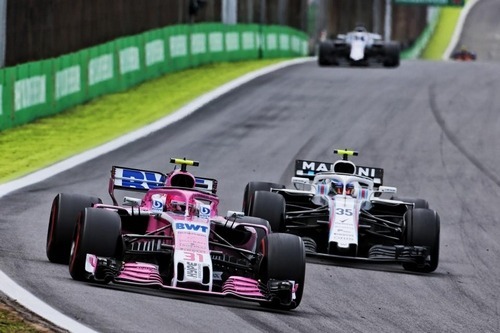
The dramatic collision between Max Verstappen and Esteban Ocon at the Brazilian Grand Prix has been a hot topic following the race, with a lot of people blaming Ocon for the incident since he was a lapped car. While I originally felt that way too, looking at the replays has caused me to change my mind. More importantly, I think that the incident highlights to issues with the current blue flag system and the blue flag mentality.
The biggest thing that I overlooked when I first saw the replays of the incident, was that Ocon was being shown the blue flags. For clarification, that was not signaled by the blue flashing lights on the inside of the first corner. Those lights are always blinking when car approach them to warn drivers exiting the pit lane that they may be driving into traffic.

That said, Ocon was certainly shown the blue flags and that can be proven by reviewing his onboard camera. Firstly, you can see the blue lights on his steering wheel, which don’t appear to illuminate until he is well within the first corner braking zone. Admittedly, I don’t know much about how the blue flags are detected, so it could be an automated system that detects when to show a blue flag, which could have been triggered by Ocon getting his nose in front of Verstappen’s car.
Secondly, you can see that the signal light at the bottom of the hill is flashing blue as well. Looking at onboard footage of that section of the track from earlier in the race, it doesn’t appear that those signal lights always blink blue like the ones at the top of the hill. Therefore, that would mean that Ocon was shown the flag.
However, it’s important to remember that the entire incident happened in a matter of seconds, so it’s possible that Ocon didn’t have time to react to the blue flags, not that he had to react to them in the first place. The blue flag rules allow the driver to ignore up to 3 blue flags before getting a penalty. This means that Ocon could have continued his overtaking attempt without penalty. This is evident by the stewards’ penalty, which was for causing a collision, not ignoring blue flags.
Regardless, this whole incident points to a bigger issue within Formula One; An issue with the blue flag system and the way that top-running drivers handle the blue flag system.

First off, the blue flag system appears to make it impossible for a driver to unlap themselves, despite there not being anything in the regulations that prevents a driver from doing that. We’ve witnessed drivers do that or attempt to do that in the past without issues. The fact that Ocon was shown the blue flag at all, despite clearly having the speed going into the corner, shows that once a driver is lapped, they aren’t expected to ever be allowed to unlap themselves, unless the front-runner pits.
The second (and perhaps larger issue) is the way that the number one drivers on the winning teams handle the blue flags. As we saw with Verstappen, winning drivers take an entirely different overtaking approach when lapping a car than they would making a regular overtake in a racing situation. We saw Verstappen move right onto the racing line in turn two, which ultimately led him into Ocon’s path. Verstappen wouldn’t have done that if he was passing Lewis Hamilton for position; he would have left the space.
This kind of “blue flag mentality” is an issue. It’s similar to the idea that a truck driver doesn’t care if there is a car in the lane that they are changing into because they are the truck, they are bigger and they know that the car will move. But in Formula One (or truck driving, for that matter) that can be a dangerous mindset to have when racing.
Ultimately, whether the car the driver is passing is on the lead lap or not, the same amount of space should be given. The fact that Ocon was a lapped car played a big factor on the stewards’ decision. Had the collision been between Verstappen and another car for a position, I can confidently say that either Verstappen would have been given a penalty for not leaving the space or the collision would have been dismissed as a racing incident.
These are the issues that the Brazilian Grand Prix highlighted and they need to be addressed or else Verstappen and Ocon colliding won’t be the last time that we will see a backmarker and leading driver crash.
Lap 44/71: Verstappen leads the #BrazilGP and then… pic.twitter.com/Bc0DRmYABH
— Formula 1 (@F1) November 12, 2018
The views and opinions expressed in this article are solely those of the author and do not necessarily reflect the official policy or position of any other agency, organization, employer or company. Assumptions made in any analysis contained within this article are not reflective of the position of any entity other than the author.